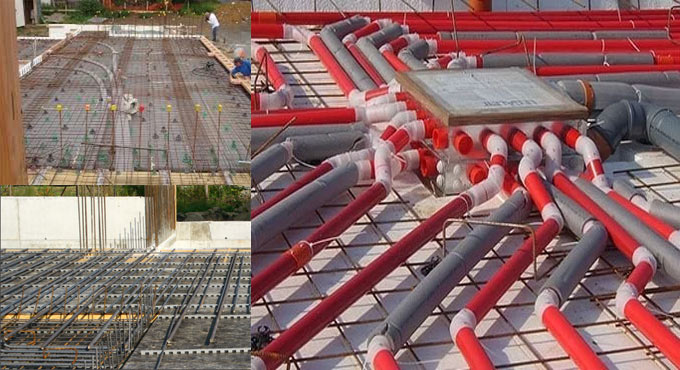
Brief overview of embedments in concrete
Embedments belong to any components like pipes, ducts, sleeves, and conduits which are arranged in concrete components for diverse purposes. Several materials are utilized to manufacture concrete elements.
Normally, embedments which are non injurious to concrete are allowed for being set up in concrete. The work should be performed in such a manner so that no risks occur on the concrete structure.
As per normal situation, all embedments produced from any materials that is not injurious to concrete and does implicate dangers to structure are permissible on the condition that the following conditions, which are provided by ACI 318-11, are met.
Passing pipes, conduits, and sleeves through slabs, beams, and walls should not be used until the strength of concrete is reduced significantly.
The setting of conduits, pipes, and their fittings implanted inside reinforced concrete columns can only be used. The total embedment area should not be over 4% of total concrete cross section that is utilized to work out the strength of column.
Conduits, pipes, and sleeves are permissible to be accepted as replacing structurally in compression the disjointed concrete when such embedments are abided by specific conditions.
As for instance, they are built up with iron or steel not narrower as compared to standard schedule 40 steel pipe, not enduring decay, lowest spacing is three diameters, and highest inside diameter is 50mm.
Pipes and conduits (in exterior dimensions) shall not be in excess of 1/3 of complete thickness of slabs, beam, or wall in which they are implanted.
Distance among pipes and conduits should be minimum three diameters or width on center.
Pipes and fittings should have been designed to resist the influence of materials, temperature, and pressure to which they are exposed.
Liquid and gas should be avoided to place into the pipe prior to concrete attains its design strength. Water is not included in this condition in case that its temperature does not exceed 32oC.
Pipes should be arranged among bottom and top reinforcement in solid slabs exclusive of those applied for snow melting and radiant heating.
Concrete cover for pipes, conduits, and fittings should be minimum 40 for concrete depending on earth or weather. When concrete is unexposed to weather or earth, minimum cover should be 20mm.
The area of reinforcement that is arranged normal to the piping should not be under 0.002 times area of concrete section.
Pipes and conduits should have been fabricated and set in an efficient manner so that they does not impact cutting, bending of reinforcements as well as induce displacement of steel bars from their specified position.
The ACI code resists the application of aluminum material in concrete excepting when it is coated or covered properly. This happens due to injurious reactions among concrete and aluminum, and steel and aluminum in the presence of chloride ions will develop. As a result, concrete cracking and spalling will take place which are not wanted.
For this reason, the Code avoids the use of calcium chloride or any admixture which include chloride in concrete with aluminum embedments. Another harmful property of aluminum is its electrical conductivity since stray electrical currents will raise speed of injurious reactions.


